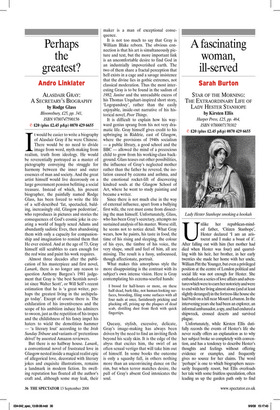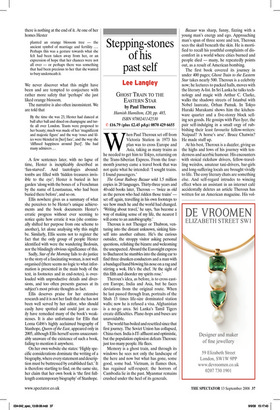A fascinating woman, ill-served
Sarah Burton
STAR OF THE MORNING: THE EXTRAORDINARY LIFE OF LADY HESTER STANHOPE by Kirsten Ellis Harper Press, £25, pp. 464, ISBN 9780007170302 ✆ £20 (plus £2.45 p&p) 0870 429 6655 Unlike her republican-minded father, ‘Citizen Stanhope’, Hester declared ‘I am an aristocrat and I make a boast of it’. After falling out with him (her mother had died when Hester was four) and quarrelling with his heir, her brother, in her early twenties she made her home with her uncle, William Pitt the Younger, but even a privileged position at the centre of London political and social life was not enough for Hester. She embarked on a series of love affairs and adventures which were to earn her notoriety and were to end with her living almost alone (and at least slightly deranged) in the fortress-like house she had built on a hill near Mount Lebanon. In the intervening years she had been an explorer, an informal ambassador, a spy, and had endured a shipwreck, crossed deserts and survived plague.
Unfortunately, while Kirsten Ellis dutifully records the events of Hester’s life she never really offers an explanation as to why her subject broke so completely with convention, and has a tendency to describe Hester’s thoughts and feelings without offering evidence or examples, and frequently gives no source for her claims. The word ‘perhaps’ is one to which biographers necessarily frequently resort, but Ellis overloads her tale with some fruitless speculation, often leading us up the garden path only to find there is nothing at the end of it. At one of her homes Hester
planted an orange blossom tree — the ancient symbol of marriage and fertility .... Perhaps this was a gesture towards what she felt had been taken away from her, or an expression of hope that her chances were not all over — or perhaps there was something that had been precious to her that she wanted to bury underneath it.
We never discover what this might have been and are tempted to conjecture with rather more safety that ‘perhaps’ she just liked orange blossom.
The narrative is also often inconsistent. We are told that
By the time she was 23, Hester had danced at ball after ball and dined on champagne and turtle all over London. Toasts were proposed to her beauty; much was made of her ‘magnificent and majestic figure’ and the way ‘roses and lilies were blended in [her] face’, and the way she ‘diffused happiness around [her]’. She had many admirers ...
A few sentences later, with no lapse of time, Hester is inexplicably described as ‘fun-starved’. And tautologies abound: tombs are filled with ‘hidden treasures invisible to the eye’; Hester is buried in her garden ‘along with the bones of a Frenchman by the name of Loustaunau, who had been buried there before’, and so on.
Ellis nowhere gives us a summary of what she perceives to be Hester’s unique achievements and the book documents Hester’s erratic progress without ever seeming to notice quite how erratic it was (she continually shifted her purpose from one scheme to another), let alone analysing why this might be. Similarly, Ellis seems not to register the fact that the only group of people Hester identified with were the wandering Bedouin, nor the blindingly obvious significance of this.
Sadly, Star of the Morning fails to do justice to the story of a fascinating woman, is not well organised (there seems no logic to what information is presented in the main body of the text, in footnotes and in end-notes), is overloaded with unproductive details and diversions, and too often presents guesses at its subject’s most private thoughts as fact.
Ellis deserves praise for her extensive research and it is not her fault that she has not been well served by her editor, who should easily have spotted and could just as easily have remedied many of the book’s weaknesses. It is also unfortunate for Ellis that Lorna Gibb’s highly acclaimed biography of Stanhope, Queen of the East, appeared only in 2005, although Ellis herself seems unaccountably unaware of the existence of such a book, failing to mention it anywhere.
On her own website she states: ‘Highly specific considerations dominate the writing of a biography, where every statement and description must be buttressed by established fact.’ It is therefore startling to find, on the same site, her claim that her own book is ‘the first fulllength contemporary biography’ of Stanhope.











































































 Previous page
Previous page